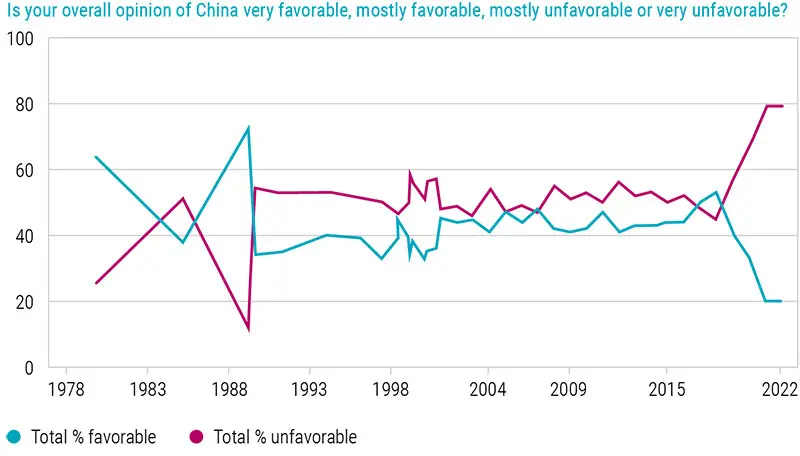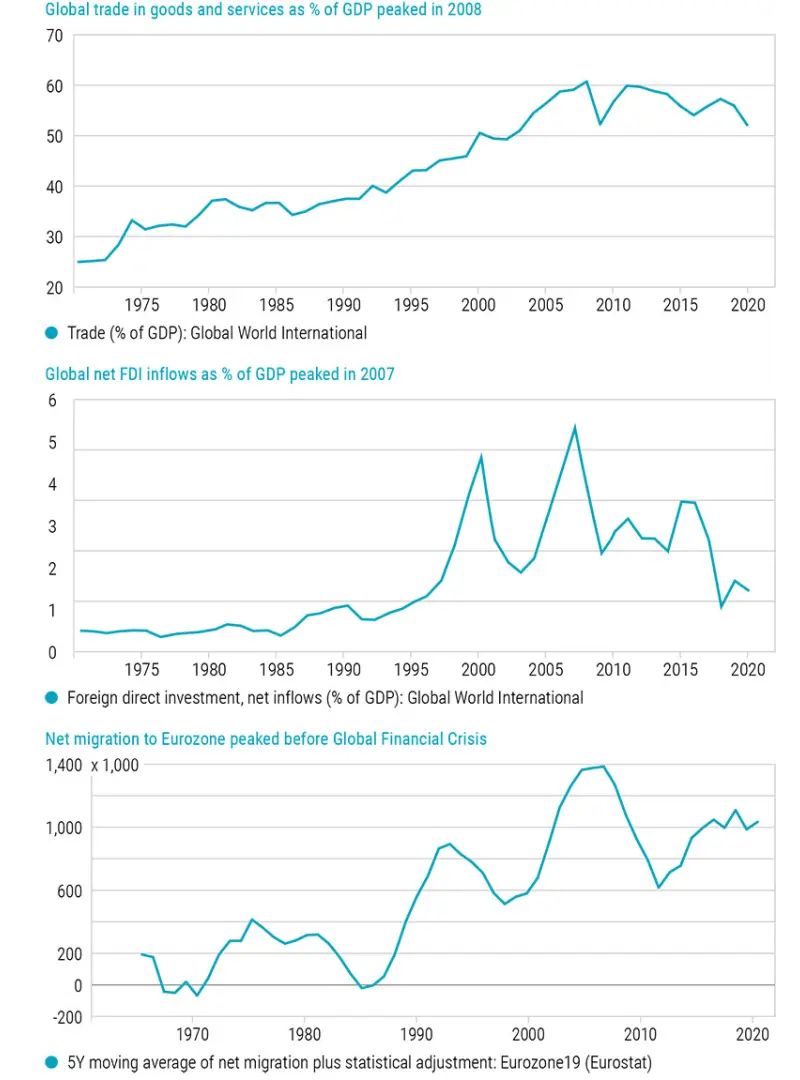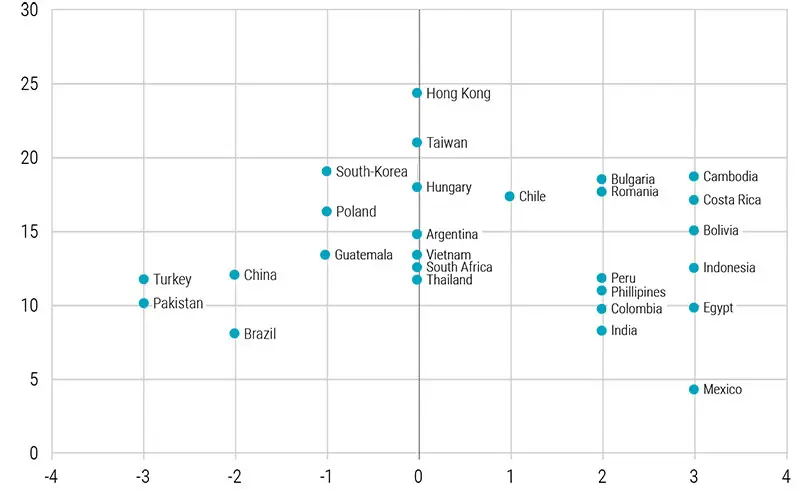Globalization is defined as the “movement of money, goods, people, ideas, technologies, and cultures across frontiers” and is a key component of international trade. The 19th century economist David Ricardo argued that it leads to greater global wealth, as each country specializes and trades in the goods in which it has a comparative advantage, a concept known as Ricardian efficiency.
Now it seems that the global economic order is turning anti-Ricardian. In contrast with the early 2000s, global leaders, governments and citizens no longer see globalization as a welcome force of nature that is futile to resist. The increasingly negative view of globalization is seen to have been instrumental in generating support for populist movements that helped Donald Trump to his 2016 presidential election by adopting his protectionist policy stance.
This can be seen in US popular opinion about China – much of whose economic success is due to exports – during the Trump administration, with 79% currently sharing an unfavorable view of the country. Creating a level playing field with China remains a priority in the Biden administration, with US President Biden declaring he would push back against Chinese “economic abuses”.
Big shift in US opinion about China

Source: Gallup
However, the tide of hyperglobalization had already started to recede before the Trump era, evidenced by a decline in the flows of goods, capital and people across borders. Global trade in goods peaked as a share of global GDP in 2008: global foreign direct investment (FDI) inflows peaked around 2007, and global migration flows to developed economies like the Eurozone also peaked before the global financial crisis. In the US, average annual immigrant population growth declined from 4.6% in the 1990-2000 decade to just 0.9% in 2015-2019.

Global trade in goods and services as a percentage of GDP peaked in 2008, while FDI inflows peaked around 2007. Source: Refinitiv Datastream, Robeco
Meanwhile, China’s globalization footprint has become more measured as its economy has grown. Richer economies typically turn more inward. Before the global financial crisis, China’s average net exports contribution of goods and services to GDP was 0.5%; post-crisis (2010-2022), this average contribution declined to 0.1%. US trade as percentage of its GDP has been declining since the 1970s.
Thus, the phenomenon of slowing globalization – or ‘slowbalization’ – is nothing new. Recent events such as Covid-19, the container ship that blocked the Suez Canal, and the Russian invasion of Ukraine have all had a reinforcing effect on global supply chain disruptions amid a surge in global goods demand. Increasing labor shortages in developed economies and precautionary inventory build-ups have added stress to a just-in-time supply chain system.
The centrifugal force of geopolitics
The centripetal pull of global economic cooperation is weakening as centrifugal forces like geopolitics and national interests become more entangled. China’s 2025 plan aims for strategic autonomy in 10 high-tech industries by achieving a 70% self-sufficiency ratio. The EU also wants to achieve strategic autonomy, while the US wants to switch its objective from fully liberalized trade to “free but secure” trade.
Corporate executives are also signaling an increasing focus on security concerns in supply chain management, with political stability emerging as a key driver. Supply chain realignments are also likely to focus more on sustainability. There is an obvious overlap between corporate commitments to reduce emissions and packaging in their supply chains and the Sustainable Development Goals such as SDG 13 (climate action) to reduce CO2 per capita.
クレジットに関する最新の「インサイト」を読む
Buying time to rethink just-in-time
Building more resilient and sustainable supply chains first and foremost changes the nature of globalization rather than its course. The share of imports as a percentage of GDP for the OECD countries has rebounded after the Covid-19 recession, with the overall share staying just below the 25-year globalization era trend.
Instead, companies seem to have bought time for a more drastic post-Covid supply chain redesign by mainly resorting to dual sourcing of materials and increasing inventory to sales levels, thereby broadening the number of supplier countries. Also, industries are following the example set by Elon Musk, looking to build resilience by increasing vertical integration to secure critical production inputs such as battery minerals and semi-conductor supply.
A more robust, but less efficient design of global supply chains will challenge corporate profitability. This elevates the risk that the anti-Ricardian streak in the coming re-design of supply chains could in the end turn out to be self-defeating.
Finding the sweet spot
We can analyze which countries tend to benefit from a different kind of globalization; one which also weighs resilience and sustainability, and thereby implicitly considers SDG impact-related factors such as the level of democracy and the nation’s environmental impact.
Countries that score well on both hard and soft factors will be in the sweet spot. We took the average rank of 27 emerging markets based on three efficiency metrics – their minimum wage in US dollars, their geographical distance to the US, and the size of their domestic labor force – and plotted that against their respective Robeco in-house SDG scores. The results can be seen in the chart below:
Ricardian efficiency rank versus SDG score

Source: Refinitiv Datastream, Robeco
Mexico emerges as the ideal candidate for US nearshoring – sourcing from a neighbor rather than globally – given the size of its labor force, outstanding SDG score, relatively attractive minimum wage level and geographical vicinity to the US market. The more interesting candidates in the sweet spot quadrant perhaps though lie in the bottom right corner, such as India, Indonesia, and Latin American countries like Peru.
Assets with an edge
We think the slowbalization trend that emerged after the global financial crisis, decelerating growth in cross-border flows, is likely to continue. From a cross-asset perspective, this implies that assets that do not react much to slowing global trade intensity could have an edge. Here, agricultural commodities (see also our special topic on food insecurity) stand out.
Conversely, emerging market debt in local currency could be particularly vulnerable in a multi-polar world as it is the most sensitive to global trade intensity. Total returns in this asset class are highly correlated with the issuing countries’ currency returns, which are ultimately driven by improving inflation differentials and real productivity growth catch-up, both of which are becoming more endangered in a fragmenting global economy.
In terms of sectors, technology emerges as the most negatively correlated with overall trade intensity, which has allowed it to defy the slowdown in overall global trade in goods and services as a percentage of global GDP. This is illustrated by the fact that international trade in digitally deliverable services has outpaced the overall exports of services during 2005-2019.
Steering an oil tanker
In summary, global value chains are like oil tankers: they need careful navigation. Therefore, shifts in the nature of slowbalization will be gradual, with companies buying time in the near term through precautionary hoarding and dual sourcing.
A pivot away from China could increasingly benefit countries with a better SDG profile, geographical proximity to the US or Europe, and attractive unit labor costs compared to China. Countries that are already relatively self-sufficient and/or have a technology tilt, such as the US, could have an edge as trade in the digitalization of services keeps outpacing growth in global goods trade.
This article is an excerpt of a special topic in our five-year outlook.
重要事項
当資料は情報提供を目的として、Robeco Institutional Asset Management B.V.が作成した英文資料、もしくはその英文資料をロベコ・ジャパン株式会社が翻訳したものです。資料中の個別の金融商品の売買の勧誘や推奨等を目的とするものではありません。記載された情報は十分信頼できるものであると考えておりますが、その正確性、完全性を保証するものではありません。意見や見通しはあくまで作成日における弊社の判断に基づくものであり、今後予告なしに変更されることがあります。運用状況、市場動向、意見等は、過去の一時点あるいは過去の一定期間についてのものであり、過去の実績は将来の運用成果を保証または示唆するものではありません。また、記載された投資方針・戦略等は全ての投資家の皆様に適合するとは限りません。当資料は法律、税務、会計面での助言の提供を意図するものではありません。 ご契約に際しては、必要に応じ専門家にご相談の上、最終的なご判断はお客様ご自身でなさるようお願い致します。 運用を行う資産の評価額は、組入有価証券等の価格、金融市場の相場や金利等の変動、及び組入有価証券の発行体の財務状況による信用力等の影響を受けて変動します。また、外貨建資産に投資する場合は為替変動の影響も受けます。運用によって生じた損益は、全て投資家の皆様に帰属します。したがって投資元本や一定の運用成果が保証されているものではなく、投資元本を上回る損失を被ることがあります。弊社が行う金融商品取引業に係る手数料または報酬は、締結される契約の種類や契約資産額により異なるため、当資料において記載せず別途ご提示させて頂く場合があります。具体的な手数料または報酬の金額・計算方法につきましては弊社担当者へお問合せください。 当資料及び記載されている情報、商品に関する権利は弊社に帰属します。したがって、弊社の書面による同意なくしてその全部もしくは一部を複製またはその他の方法で配布することはご遠慮ください。 商号等: ロベコ・ジャパン株式会社 金融商品取引業者 関東財務局長(金商)第2780号 加入協会: 一般社団法人 日本投資顧問業協会
